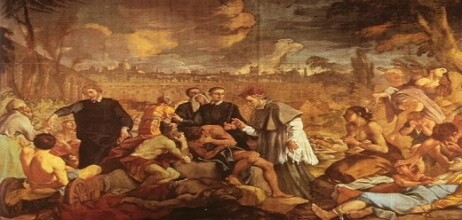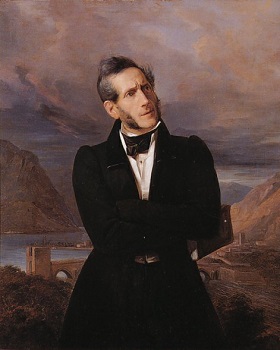In the period between early March and early April of this year, as the Covid-19 Pandemic raged in Italy and the numbers of cases and victims rose exponentially, particularly in the infection’s epicentre in Lombardy, a number of Italian newspapers, both local and national, made explicit comparisons with another famous epidemic that struck northern Italy almost four hundred years ago: the 1630 Bubonic Plague of Milan.
The epidemic is the backdrop of the most important work in Italian literature after Dante’s Divine Comedy, Alessandro Manzoni’s The Betrothed (I promessi sposi, 1842, revised edition). Manzoni’s work offers a powerful insight into the moment of the plague, with parallels in our own time. The novel tells the story of a young couple, Renzo and Lucia, sworn to be married in seventeenth-century Lombardy, amidst the Spanish domination of the region, with its corollaries of violence and corruption, the local military involvement in the major European wars of the period, and the 1630 plague, which killed a large part of the population of Milan and of several towns and villages in the area. Italian children learn about Manzoni’s novel in school, and therefore a passing knowledge of the 1630 plague is commonplace among Italians (based on detail in three chapters of the book – XXXI, XXXII, and XXXIII , as well as in an Appendix called History of the Pillar of Infamy (Storia della colonna infame)).
There are obvious differences between the 1630 plague and the Covid-19 pandemic, related not just to the vastly different historical periods, but also to the fact that the Bubonic Plague was caused by a bacterium, while Covid-19 is a virus. The mortality rate was much higher in the former than in the latter (in Milan alone, 46% of the population died as a result, or 60,000 out of 130,000 people). Moreover, geographically, the 1630 plague probably started in northern Lombardy and hit Milan particularly hard, while Covid-19 started in southern Lombardy and hit the towns south and east of Milan much more than Milan itself.
Yet, there are certainly striking similarities with regard to the human element and the response to the two catastrophes, the behaviour of the authorities and of the people in general, and also of individuals in particular, together with more objective issues such as the ideas about the origins of the disease and its diffusion, and its effects on society and the economy.
Manzoni was a master of creating portraits of unforgettable characters, representing the entire spectrum of human behaviour, from cowardice to heroism, against the backdrop of real historical events, which he reconstructed through a painstaking work of reading and interpreting archival sources. It is no surprise, then, that several northern Italian teachers have urged their pupils to read Manzoni’s chapters on the 1630 plague in light of the current Covid-19 pandemic. Even Pope Francis, in one of his March 2020 homilies, referred to the different behaviours of the characters in The Betrothed by way of comparison with the present crisis.


Published: 17 Apr 2020

